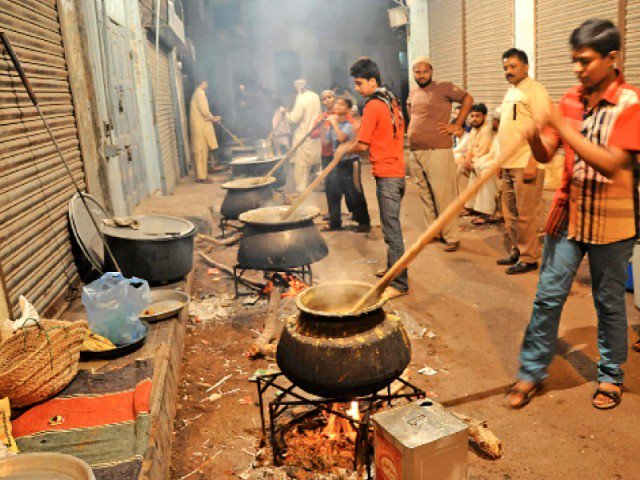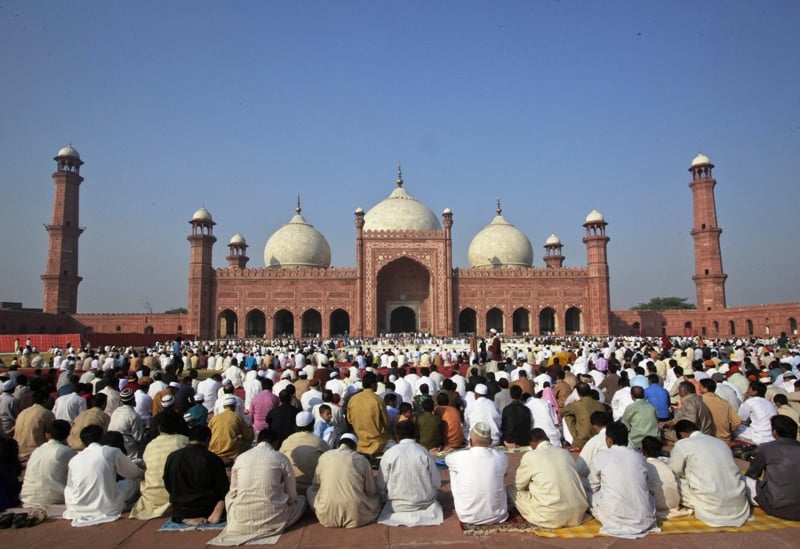
The preparation of haleem gains momentum from the night of Muharram 8 and continues throughout the month of Muharram. People participate in large numbers at make-shift food camps set up to offer biryani and haleem, accompanied by water and beverages especially from 8th to 10th of Muharram. The traditional recipe for haleem takes hours to cook and is prepared in large cauldrons (daigs).
Every year, the price of ingredients goes up in Muharram due to an increase in demand. The price of utensils and firewood used to cook the meal also goes up. Moreover, a shortage of cauldrons results in a manifold increase in their rent.
Procuring daigs
Cauldrons are procured from rural Sindh and Punjab to overcome this shortage but even then, according to catering service providers, renting a cauldron on 8th or 9th Muharram is virtually impossible. The daily rent in this month, which would ordinarily be in the range of Rs300 to Rs400 shoots up to a range of Rs1,000 to Rs1,200.
Not only the rents but the prices of cauldrons have also increased. While just last year the price of a bronze cauldron was Rs900 per kg, this year it was reported at Rs1,000 per kg. The price of a silver cauldron is Rs400 per kg. A bronze cauldron weighs between 20 to 22 kg while the silver one is usually 15 to 16 kg in weight.
Due to the increase in the price of bronze and increasing incidents of theft, the demand for bronze cauldrons has decreased. Consequently, silver caudrons are higher in demand even though they seem to have a lesser shelf life and do not offer the traditional taste in haleem.
Pakwan centres
In addition to homes, haleem is also prepared at commercial pakwan centres. Those living in apartments prefer getting haleem prepared at the pakwan centres where the preparation of haleem is relatively easier and less time consuming. However, in the month of Muharram these centres do not take orders past the 7th because of the large number of orders.
The rise in prices of meat, oil, spices and cereals used in haleem is also reflected in the price tags of pakwan centres. A 10-kilogramme (kg) beef haleem daig costs Rs12,000 and the same in chicken is priced at Rs10,000. A 10-kg daig of haleem can serve up to 100 people.
In most centres, haleem is mixed using industrial-sized grinder machines, which reduce an hour-long job to a mere 15 to 20 minutes. But, in comparison, haleem mixed with manual wooden sticks takes time to prepare but offers a better taste.
Ghota
The wooden stick used for mixing haleem, called ghota, is also sold along with the daigs. The ghota made from tamarind wood sells for Rs150 while that made from sheesham is priced between Rs300-400. Those who want to procure ghotas on rent pay between Rs50 to Rs60 a day. A large ladle used along with ghota costs around Rs800 to buy and is rented out for Rs100 to Rs150.
Firewood
The rent for iron stoves used for cooking haleem has also gone up from Rs100 to Rs150 while its selling price is Rs700.
People also choose to cook haleem on firewood as it offers a unique taste. Those making haleem on the road side or outside their homes make use of Keekar wood. This year, the price of wood has increased by Rs100, with Keeker wood being sold at Rs800 compared to the previous Rs700. A typical deg of haleem consumes about 40 kg of wood. The price for dry wood is Rs50-100 higher than the price of wood containing moisture. The wood dealers start collecting their inventory two months ahead of Muharram. The wood is first dried up in open fields before it arrives at the shops. Wood meant for building material and discarded furniture items are also commonly used to power flames for haleem daigs. However, the keekar wood with its stable flames offers even heat for the daig and results in a better taste of haleem.
Published in The Express Tribune, September 24th, 2018.























COMMENTS
Comments are moderated and generally will be posted if they are on-topic and not abusive.
For more information, please see our Comments FAQ